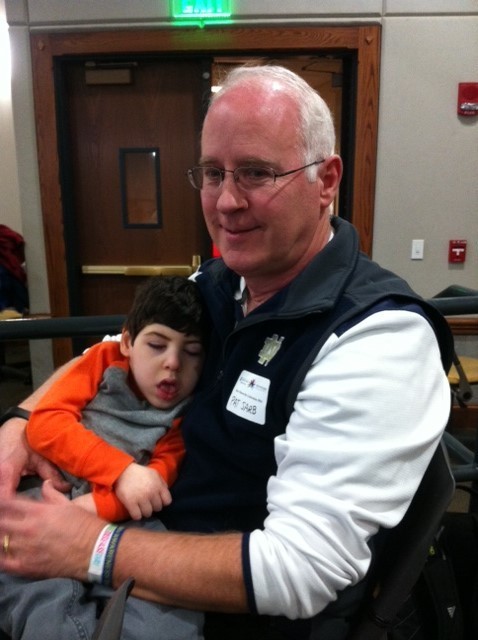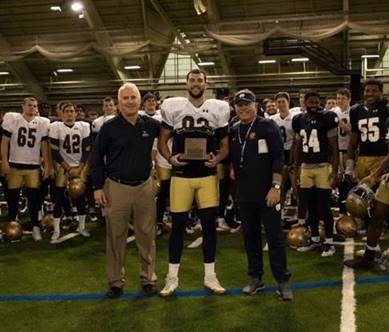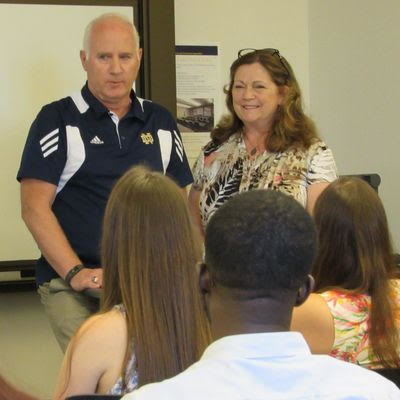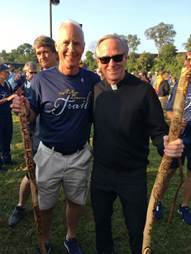
Sustaining business, sustaining relationships, sustaining life – Patrick Sarb ’76 practices sustainability even when it’s not for a job description. As AllState Environmental Sciences Senior Manager, Pat has spent 15 years managing AllState’s corporate sites across the United States and Canada. Over his career at AllState, Pat has supported the development of a sustainability department, while promoting environmental considerations across department lines. He thinks back to his master’s in Environic Design at Notre Dame, remembering how it laid the foundation for his interdisciplinary thinking.
The Environic Design program was an environmental design and planning program based in the Department of Architecture when it was part of the College of Engineering. It was very interdisciplinary. Pat’s thesis, titled “Resource Use and Reuse Towards Economic Maturity: Economic and Environic Considerations for Resource Protection” also laid a foundation for his thinking about the economic use of resources.
His first job out of college was at an engineering firm based in Kansas City, MO, where he conducted site studies on the socioeconomic impacts of coal-fired power plants. He has also created environmental impact reports for an aviation planning firm in Chicago, and has spent most of his career with environmental compliance work. While this continued at AllState, his transition to the insurance company was a transition to complying with environmental regulation in every U.S. state, as well as Canada. Managing the environmental conditions of corporate properties across state and country lines is very different than managing compliance within Kansas City or Chicago.
For his first ten years at AllState, Pat was the only environmental person in the company and his job was mostly reactive. He managed environmental compliance regarding air quality, spill plans, water quality and disaster damage, responding to floods, fires and hurricanes. Today, Pat plays a more proactive role, ensuring consistent air and water quality within their buildings, while also helping prepare the company ahead of time so damage from disasters is minimal. Beyond minimizing damage, he also serves on the AllState Sustainability Council.
While Pat does have to know the regulations of all of the states and provinces with AllState facilities, the efforts he manages are driven by more than compliance these days. AllState began taking simple steps towards sustainability early on, like cutting back on paper usage and shifting to electronic billing, and the company has been increasing its sustainability efforts over the years.
“Corporate sustainability efforts that are reviewed by Ceres, the Carbon Disclosure Project (CDP), etc. are driven by the economic, social responsibility, and governance (ESG) framework as much as by environmental regulations,” Pat explains. Organizations like the nonprofits he mentions encourage companies to understand and report their impact on the environmental as well as social and ethical issues, so investors can understand a company’s full impact on society. Companies often find that high marks in environmental, social and governance metrics correspond to saving money and attracting investors.
AllState didn’t have a corporate environmental policy or a sustainability group 12 years ago, but started getting letters from large environmental nonprofits. These organizations were asking what AllState was doing about sustainability. “So the Vice President that I reported to asked me to put a corporate response together and so I did. But I realized that this all had to come from our Corporate Relations Department and approved by our Legal Department.” Since then, Pat has continued to advise on AllState’s sustainability efforts, even as they shifted to the appropriate department.

Pat’s long history with team sports contributes to his ability to effectively work across departments. "I’m used to working from a team concept, that is getting everyone’s input and making sure everyone has a say in what’s happening,” Pat says. It turns out that this is crucial for fostering corporate sustainability, as well as winning football championships. In fact, Pat’s willingness to contribute to the team went down in history when he gave up his jersey so Rudy Reuttiger could play during his final home game of 1976. “The scene with the players putting their jerseys on Coach Devine’s desk didn’t happen like it did in the movie,” Pat says. “But much of the movie was pretty accurate actually.”

His grandson suffers from a rare genetic diseases called Non-Ketotic Hyperglycemia (NKH). In December 2014, Pat and his wife, Lynda, created a fund to study the disease. Since then, they have been speaking to Notre Dame classes and participating in ND Day fundraising and other opportunities to raise funds or awareness for NKH and the Boler-Parseghian Center. Their grandson just turned seven and the research team that has been at it for almost four years hopes to one day find a cure.Pat’s connections to Notre Dame are many: he is the middle of three generations of football players; his cousin was a spiritual advisor to Father Hesburgh as a Holy Cross priest in the Vatican; he was one of 32 travelers who walked the entire Notre Dame trail to celebrate Notre Dame’s bicentennial, to name a few. Standing out personally for Pat though is his work to sustain life by funding and supporting research by Notre Dame’s Boler-Parseghian Center for Rare and Neglected Diseases.

It was hard for Pat to express his appreciation for Notre Dame in words, but he settled on “friendship and family.” That defines the university for him and symbolizes his ongoing relationship with many of its facets. He saw the niches he could fill and continues to wholeheartedly fill them. His advice to current sustainability students echoes this theme. “It can be frustrating because there are so many ways professionally to approach sustainability,” Pat says. “But that can also be a positive. Keep pursuing what your main interests are and you’ll find something eventually.”